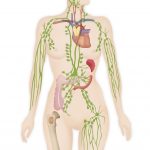 Unlike the heart in the blood circulatory system, the lymphatic system does not have an active pump to propel lymphatic fluid back to the bloodstream. Effective lymph flow depends on sufficient muscle and joint activity, especially if the functionality of the lymphatic system is compromised
Unlike the heart in the blood circulatory system, the lymphatic system does not have an active pump to propel lymphatic fluid back to the bloodstream. Effective lymph flow depends on sufficient muscle and joint activity, especially if the functionality of the lymphatic system is compromised
The thoracic duct is the largest lymphatic vessel in the human body. It drains the lower extremities, pelvis, abdomen, left side of the thorax, left upper extremity, and left side of the head and neck. Around 75% of the lymph from the entire body. The right lymphatic duct drains the right upper limb, right breast, right lung and right side of the head and neck.
The thoracic duct extends from the twelfth thoracic vertebrae to the root of the neck. The thoracic duct is formed from the abdominal confluence (juncture) of the left and right lumbar lymph trunks, as well as the left and right intestinal lymph trunks between T12 and L2.
The lymph transport in the thoracic duct is mainly caused by the action of breathing aided by the duct’s smooth muscle and by internal valves which prevent the lymph from flowing back down again.
Abdominal (diaphragmatic) breathing exercises are a valuable tool in stimulating deep lymphatic structures, such as the cisterna chyli, the abdominal part of the thoracic duct, lumbar trunks, and lumbar lymph nodes, pelvic lymph nodes, and certain organ systems.
Lymph fluid from the lower extremities passes through these deep lymphatic structures and an increased flow of lymph, particularly in the thoracic duct, results in improved lymphatic drainage from the lower extremities. Individuals affected by lymphedema greatly benefit from diaphragmatic breathing exercises, especially when combined with a comprehensive decongestive exercise regimen.
Stimulation of these deep lymphatic structures, in particular the thoracic duct (the largest lymph vessel in the body), accelerates the transport of lymph fluid toward the venous angles (15), through which the lymph fluid is returned into the blood circulatory system.
The up and down movement of the diaphragm during deep abdominal breathing is an essential component for the sufficient return of lymphatic fluid back to the bloodstream.
The movement of the diaphragm, combined with the outward and inward movements of the abdomen, assist in the return of venous blood back to the heart.
Another issue that may play an indirect role in the occurrence and severity of lymphedema is pectoralis minor syndrome. It is characterized by axillary vein obstruction below the clavicle, provoked by compression from the pectoralis minor muscle. Clinical presentation is portrayed as pain, weakness, cyanosis, numbness, paresthesia, and swelling of the upper extremity. It is considered as a subset of thoracic outlet syndrome.
A shortened pec minor (injury, surgery, radiation, breathing dysfunction, or anterior/posterior muscle imbalance), can lead to upper-crossed syndrome (forward head and rounded shoulders). This action is called protraction and is opposed by the muscles of retraction such as the middle trapezius and the rhomboids. Commonly the pectoralis minor becomes hypertonic and the middle trapezius becomes inhibited. Release of the pectoralis minor followed by strengthening of the middle trapezius can be very effective in improving posture as well as minimizing any associated pain from related ischemia. Because the pectoralis minor rounds the shoulder, it is opposed by the latissimus dorsi. Strengthening the latissimus dorsi can be invaluable in correcting posture as well as improving shoulder range of motion.
Incorporating a gentle stretching routine that is designed to stretch tight (hypertonic) muscles as well as open lymphatic pathways, may minimize the vein obstruction and allow for improved lymphatic flow.
Scar tissue is another culprit that may not present for 1.5-2 years post surgery and radiation. Unlike superficial wounds, surgical scar tissue doesn’t just exist on the surface of the body. Scar tissue can extend from the skin all the way down to bones and organs. Sometimes these scars become hard and fibrotic and obstruct lymphatic circulation. Working with a PT or OT who can assist with scar tissue massage and manipulation can be very helpful in preventing the onset of lymphedema and/or minimizing symptoms.
As part of the Cancer Exercise Training Institute’s comprehensive oncology exercise training, health and fitness professionals learn recommended lymph drainage exercises, appropriate incorporation of cardiovascular, balance, range of motion, and strength training exercises, and proper exercise progression to ensure the safety and efficacy of the exercise program.
Students also learn about the acute and chronic side-effects of cancer surgery and treatment and how they can be prevented or minimized with the proper exercise prescription. To learn more please visit CETI.teachable.com

